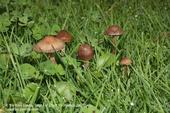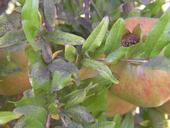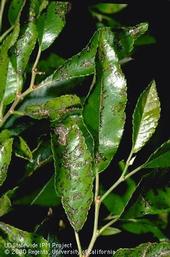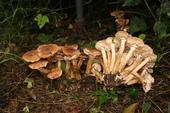- Author: Karey Windbiel-Rojas
![Thinning canopy is an early sign of Bot canker. [Credit: J. Downer]](https://ucanr.edu/blogs/UCIPMurbanpests/blogfiles/93035small.jpg)
- Author: Elaine Lander

(Credit: RM Davis)
Recent rainfall and cool weather in many parts of the state are favorable for mushrooms that you may have been seeing in lawns. While they may be a surprising sight, mushroom-producing fungi are generally not considered to be a pest because most do not cause lawn diseases. Armillaria mushrooms indicate the presence of decaying tree roots below ground. Other mushrooms decompose underground organic matter and may be considered beneficial since they make nutrients available to lawns and other plants.
Mushrooms are the visible reproductive structures of some types of fungi. Picking or removing the structures can minimize the spread to a new site, but it won't kill the underground mycelia from which the mushrooms are growing....
- Author: Belinda J. Messenger-Sikes
- Author: Karey Windbiel-Rojas
- Author: Elaine Lander

Sooty mold is a black fungal growth that looks like a layer of soot covering the leaves of a plant or a sidewalk. The aptly named disease is common in gardens and landscapes, appearing wherever a large infestation of plant-sucking insects are found. Sooty mold grows on honeydew, a sticky substance excreted by plant-sucking insects.
While sooty mold doesn't actually damage plants or other surfaces, a thick growth of the fungus can block light to plant leaves, reducing photosynthesis. This can lead to stunted growth and premature leaf drop.
The key to reducing sooty mold is management of honeydew-producing insects,...

(Credit: Jack Kelly Clark)
Anthracnose is a group of fungal diseases that infect many trees and shrubs, causing dark lesions on leaves and cankers on twigs and stems. In some areas of California, vegetables and turfgrass can also be infected with anthracnose.
Symptoms of anthracnose vary by plant host and weather conditions. High humidity and dense canopies can exacerbate this common disease. Management relies on planting resistant cultivars of landscape plants along with careful maintenance of susceptible cultivars, such as pruning and removal of fallen leaves and twigs.
Authors Jim Downer (UCCE Ventura County), Steven Swain (UCCE Marin County), and Amanda Crump (UC Davis Plant Sciences) recently revised

What is Armillaria Root Rot?
Armillaria root rot is a severe fungal disease that affects trees, woody plants, and some herbaceous plants including palms and succulents.
Also known as oak root fungus, Armillaria root rot can rapidly kill trees and presents a challenge to management since infected woody roots can persist for years underground. No plants are completely immune to Armillaria root rot, so prevention is key. Deeply planted trees are often more susceptible to this disease.
The distinctive “honey mushrooms” growing from the base of a tree signals an infection, but they may not always be present. Other visible symptoms include flat cankers on the trunk, wilting, and canopy...


